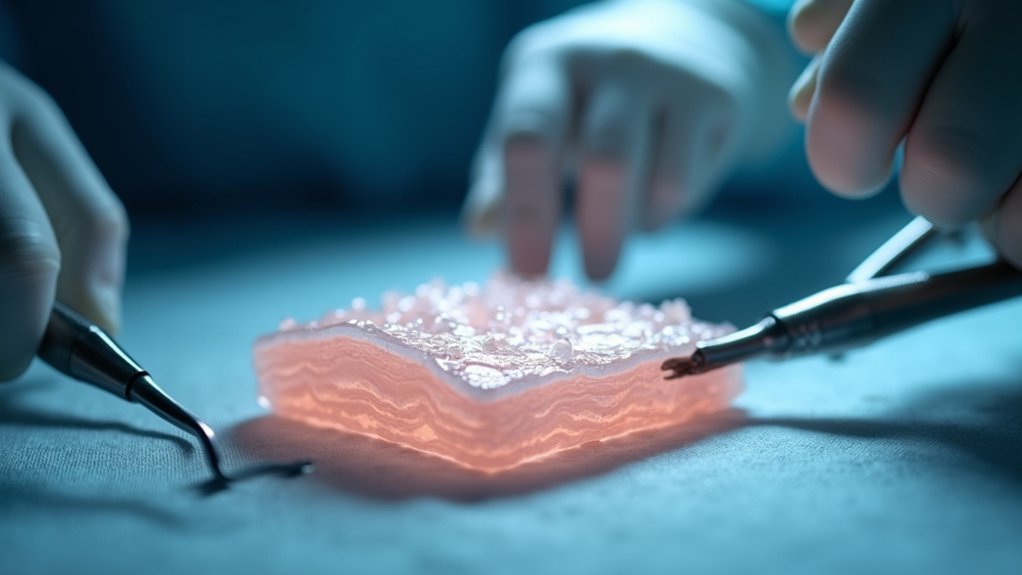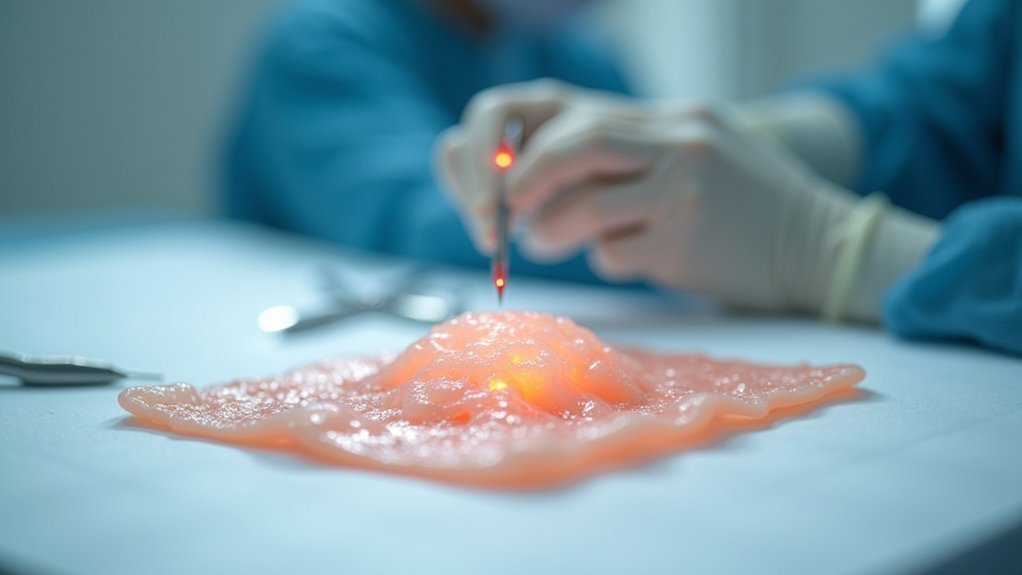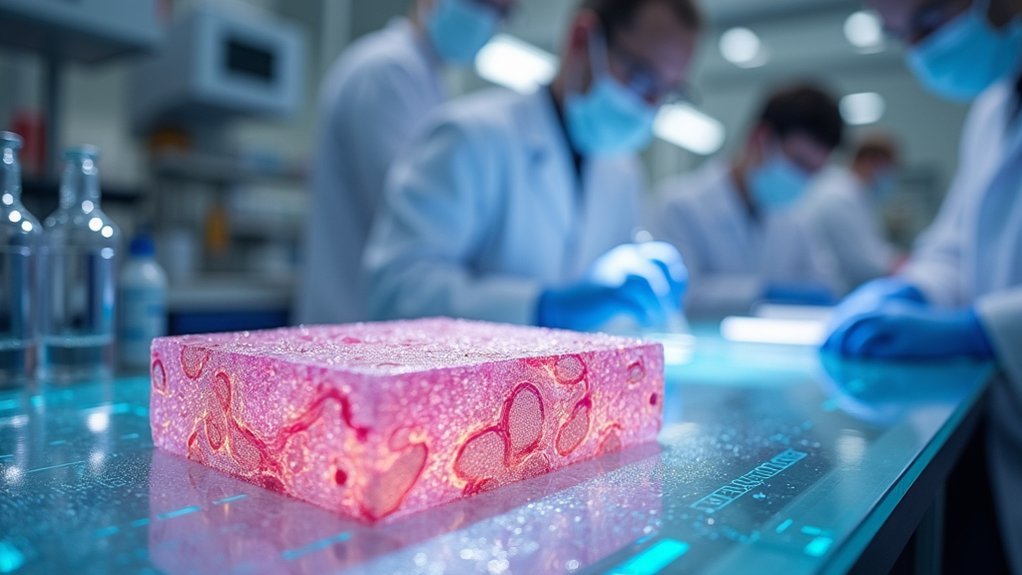You’ll find bioprinted skin grafts revolutionizing five key medical areas: burn treatment where patient-specific grafts heal wounds in half the time, diabetic ulcer care with personalized healing solutions, cosmetic surgery offering superior aesthetic outcomes without rejection risks, pharmaceutical research replacing animal testing with human-like tissue models, and disease modeling using patient-derived cells for targeted therapy development. These applications showcase how 3D bioprinting creates functional, multi-layered skin constructs that integrate seamlessly with your natural tissue, transforming treatment possibilities across multiple medical specialties.
Burn Injury Treatment and Reconstruction

While traditional skin grafts have long served as the standard treatment for severe burns, 3D bioprinting now offers a revolutionary approach that creates patient-specific grafts directly from your own cells.
This technology produces multi-layered skin constructs that mirror natural skin structure, dramatically improving wound healing outcomes. When you receive bioprinted skin grafts made from bio-inks derived from your cells, you’ll experience minimal immune response and enhanced tissue integration compared to conventional treatments.
Clinical applications show remarkable results—bioprinted grafts can achieve wound closure in half the time of untreated burn injuries.
Bioprinted skin grafts demonstrate exceptional healing performance, reducing wound closure time by 50% compared to leaving severe burns untreated.
Future developments aim to incorporate skin appendages like hair follicles and sweat glands, providing extensive reconstruction solutions that’ll transform how medical professionals treat severe burns.
Chronic Wound Healing and Diabetic Ulcers
Although chronic wounds like diabetic ulcers affect millions of patients worldwide and drain healthcare resources through extended treatment periods, 3D bioprinted skin grafts now provide targeted solutions for these persistent healing challenges.
You’ll find that these advanced skin grafts utilize patient-specific cells to create personalized treatment options that markedly improve healing outcomes while reducing complications associated with foreign tissue rejection.
The technology transforms chronic wound treatment through:
- Accelerated healing rates – Bioprinted skin closes wounds in half the time compared to untreated options
- Customized graft design – Advanced imaging guarantees precise matching to wound dimensions and characteristics
- Reduced healthcare costs – Faster recovery times decrease overall treatment expenses and hospital stays
Using bioink derived from your adipose tissue, these grafts offer unprecedented personalization for diabetic ulcers and other persistent wounds.
Cosmetic and Reconstructive Surgery

When reconstructive surgeons need to restore damaged tissue from trauma, cancer removal, or congenital defects, 3D bioprinted skin grafts offer unprecedented precision and aesthetic outcomes that traditional transplantation methods can’t match.
3D bioprinted skin grafts deliver unmatched precision and aesthetic results that traditional transplantation simply cannot achieve.
You’ll benefit from patient-specific bioinks derived from your own cells, eliminating rejection risks while ensuring seamless integration with surrounding tissues.
Bioprinting technology creates mechanically superior continuous grafts rather than pieced-together patches, dramatically improving surgical outcomes.
These engineered skin grafts can incorporate essential features like hair follicles and sweat glands, delivering both functional restoration and natural aesthetics for cosmetic interventions.
You’ll experience reduced surgical times and fewer complications, making reconstructive surgery more efficient and effective than ever before.
Drug Testing and Pharmaceutical Research
Beyond surgical applications, bioprinted skin grafts are revolutionizing pharmaceutical research by providing researchers with human-like tissue models that eliminate the need for animal testing while delivering unprecedented accuracy in drug development.
These realistic tissue models offer superior predictions of drug absorption, metabolism, and toxicity compared to traditional cell cultures, while maintaining excellent cell viability throughout testing periods.
You’ll find bioprinted skin enables high-throughput screening of multiple compounds simultaneously, dramatically reducing development costs and timelines. The integration of vascular networks enhances functionality by facilitating proper nutrient exchange, mimicking actual human tissue responses.
- Disease-specific modeling: You can replicate specific skin diseases for targeted therapy testing and personalized medicine approaches
- Enhanced accuracy: Drug testing results better predict human responses than animal models
- Cost efficiency: Pharmaceutical research becomes faster and more economical through streamlined processes
Skin Disease Modeling and Therapeutic Development

Bioprinted skin grafts excel at creating precise disease models that capture the genetic and cellular complexities of various skin conditions. When you’re developing therapeutic interventions, these bioprinted skin constructs provide invaluable insights into disease mechanisms using patient-derived cells that exhibit specific genetic traits.
You’ll find that in vitro models closely mimic human skin, enabling more effective study of chronic wounds and inflammatory conditions. Through skin disease modeling, you can examine healing processes and evaluate how different therapies impact skin regeneration.
This approach supports drug testing directly on human-like tissue, reducing animal model dependence. The ability to create patient-specific bioprinted skin facilitates personalized medicine approaches, allowing you to develop targeted therapeutic development based on individual skin characteristics and unique disease profiles for ideal treatment outcomes.
Frequently Asked Questions
What Are the Applications of Bioprinting?
You’ll find bioprinting creates organs, tissues, and medical implants for transplants. It’s used for drug testing, disease modeling, personalized medicine development, and manufacturing prosthetics, revolutionizing healthcare through customized biological solutions.
Could Bioprinted Organs Be Used for Transplants?
You’ll likely see bioprinted organs used for transplants as technology advances. They’re already showing promise with patient-specific cells reducing rejection rates, though regulatory approval and vascular integration challenges remain.
How Will Skin Bioprinting Help Patients?
You’ll receive personalized grafts from your own cells, avoiding rejection risks. You’ll experience faster healing with 50% quicker wound closure, reduced hospital visits, and eventually restored complex skin functions like sensation.
What Is the Application of Bioprinting in Ophthalmology?
You’ll benefit from bioprinted corneal grafts that use your own cells, reducing rejection risks. Bioprinting creates scaffolds supporting tissue regeneration in your cornea, retina, and sclera while restoring vision from injuries.





Leave a Reply